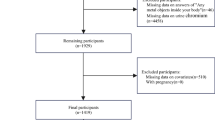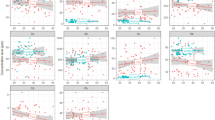Abstract
Arsenic, cadmium and lead are well-known toxic metals, and there are substantial studies on variability of these metals in urine to optimize design of exposure assessment. For urinary levels of other nonessential metals such as aluminum (Al), antimony (Sb), barium (Ba), thallium (Tl), tungsten (W) and uranium (U), however, their within-individual and between-individual variability are unclear. Therefore, we collected 529 samples from 11 healthy adult men on 8 days during a 3-month period. We measured urinary metals and creatinine (Cr) levels, assessed the reproducibility using intraclass correlation coefficients (ICCs), and performed sensitivity and specificity analyses to assess how well 1, 2 or 3 specimens could classify exposure. Al, Sb, Ba, W and U levels measured from spot samples varied greatly over days and months (Cr-adjusted ICCs = 0.01–0.14). Serial measures of Tl levels measured from spot samples had fair-to-good reproducibility over 5 consecutive days (Cr-adjusted ICC = 0.40), but worsened when the specimens were collected months apart (Cr-adjusted ICC = 0.16). To identify men who were highly exposed (top 33%) based on their 3-month averages, tests of single spot samples and tests of first-morning voids had high specificities (0.73–0.85) but relatively low sensitivities (0.27–0.60). Collection of repeated urine specimens from each individual improved the classification.
This is a preview of subscription content, access via your institution
Access options
Subscribe to this journal
Receive 6 print issues and online access
$259.00 per year
only $43.17 per issue
Buy this article
- Purchase on SpringerLink
- Instant access to full article PDF
Prices may be subject to local taxes which are calculated during checkout

Similar content being viewed by others
References
USEPA (Environmental Protection Agency). Code of federal regulations: priority pollutants list. Visited: 2016-7-5. https://www.gpo.gov/fdsys/pkg/CFR-2014-title40-vol29/xml/CFR-2014-title40-vol29-part423-appA.xml. Accessed 10 Sept 2016.
Bondy SC. Low levels of aluminum can lead to behavioral and morphological changes associated with Alzheimer’s disease and age-related neurodegeneration. Neurotoxicology. 2016;52:222–9.
Kravchenko J, Darrah TH, Miller RK, Lyerly HK, Vengosh A. A review of the health impacts of barium from natural and anthropogenic exposure. Environ Geochem Health. 2014;36:797–814.
Nigra AE, Ruiz-Hernandez A, Redon J, Navas-Acien A, Tellez-Plaza M. Environmental metals and cardiovascular disease in adults: a systematic review beyond lead and cadmium. Curr Environ Health Rep. 2016;3:416–33.
Xia W, Du X, Zheng T, Zhang B, Li Y, Bassig BA, et al. A case-control study of prenatal thallium exposure and low birth weight in China. Environ Health Perspect. 2016;124:164–9.
Dezateux C, Delves HT, Stocks J, Wade A, Pilgrim L, Costeloe K. Urinary antimony in infancy. Arch Dis Child. 1997;76:432–6.
Angenard G, Muczynski V, Coffigny H, Duquenne C, Frydman R, Habert R, et al. In vitro effects of Uranium on human fetal germ cells. Reprod Toxicol. 2011;31:470–6.
Gregotti C, Di Nucci A, Costa LG, Manzo L, Scelsi R, Berte F, et al. Effects of thallium on primary cultures of testicular cells. J Toxicol Environ Health. 1992;36:59–69.
Klein JP, Mold M, Mery L, Cottier M, Exley C. Aluminum content of human semen: implications for semen quality. Reprod Toxicol. 2014;50:43–48.
Ballester J, Dominguez J, Munoz MC, Sensat M, Rigau T, Guinovart JJ, et al. Tungstate treatment improves Leydig cell function in streptozotocin-diabetic rats. J Androl. 2005;26:706–15.
Kwon B, Ha N, Jung J, Kim PG, Kho Y, Choi K, et al. Effects of barium chloride exposure on hormones and genes of the hypothalamic-pituitary-gonad axis, and reproduction of zebrafish (Danio rerio). Bull Environ Contam Toxicol. 2016;96:341–6.
Rotter I, Kosik-Bogacka DI, Dolegowska B, Safranow K, Kuczynska M, Laszczynska M. Analysis of the relationship between the blood concentration of several metals, macro- and micronutrients and endocrine disorders associated with male aging. Environ Geochem Health. 2016;38:749–61.
Hao Y, Li R, Leng Y, Ren J, Liu J, Ai G, et al. The reproductive effects in rats after chronic oral exposure to low-dose depleted uranium. J Radiat Res. 2012;53:377–84.
Schulz C, Conrad A, Becker K, Kolossa-Gehring M, Seiwert M, Seifert B. Twenty years of the German Environmental Survey (GerES): human biomonitoring—temporal and spatial (West Germany/East Germany) differences in population exposure. Int J Hyg Environ Health. 2007;210:271–97.
Health Canada. 2010. Report on human biomonitoring of environmental chemicals in Canada. Results of the Canadian Health Measures Survey Cycle 1 (2007–2009). http://www.hc-sc.gc.ca/ewh-semt/alt_formats/hecs-sesc/pdf/pubs/contaminants/chms-ecms/report-rapport-eng.pdf Accessed 10 Sept 2016.
CDC (Centers for disease control and prevention), 2014. Fourth national report on human exposure to environmental chemicals. Updated tables, August, 2014. http://www.cdc.gov/exposurereport/pdf/fourthreport_updatedtables_aug2014.pdf Accessed 10 Sept 2016.
Fréry N, Saoudi A, Garnier R, Zeghnoun A, Falq G. Exposition de la population française aux substances chimiques de l’environnement. Institut de veille sanitaire, Saint-Maurice. In, 2011.
Feng W, He X, Chen M, Deng S, Qiu G, Li X, et al. Urinary metals and heart rate variability: a cross-sectional study of urban adults in Wuhan, China. Environ Health Perspect. 2015;123:217–22.
Wang YX, Sun Y, Feng W, Wang P, Yang P, Li J, et al. Association of urinary metal levels with human semen quality: a cross-sectional study in China. Environ Int. 2016;91:51–59.
Aylward LL, Hays SM, Smolders R, Koch HM, Cocker J, Jones K, et al. Sources of variability in biomarker concentrations. J Toxicol Environ Health B Crit Rev. 2014;17:45–61.
Barr DB, Wilder LC, Caudill SP, Gonzalez AJ, Needham LL, Pirkle JL. Urinary creatinine concentrations in the U.S. population: implications for urinary biologic monitoring measurements. Environ Health Perspect. 2005;113:192–200.
Gunier RB, Horn-Ross PL, Canchola AJ, Duffy CN, Reynolds P, Hertz A, et al. Determinants and within-person variability of urinary cadmium concentrations among women in northern California. Environ Health Perspect. 2013;121:643–9.
Kile ML, Hoffman E, Hsueh YM, Afroz S, Quamruzzaman Q, Rahman M, et al. Variability in biomarkers of arsenic exposure and metabolism in adults over time. Environ Health Perspect. 2009;117:455–60.
Smolders R, Koch HM, Moos RK, Cocker J, Jones K, Warren N, et al. Inter- and intra-individual variation in urinary biomarker concentrations over a 6-day sampling period. Part 1: metals. Toxicol Lett. 2014;231:249–60.
Wang YX, Feng W, Zeng Q, Sun Y, Wang P, You L, et al. Variability of metal levels in spot, first morning, and 24-hour urine samples over a 3-month period in healthy adult Chinese men. Environ Health Perspect. 2016;124:468–76.
Vacchi-Suzzi C, Porucznik CA, Cox KJ, Zhao Y, Ahn H, Harrington JM, et al. Temporal variability of urinary cadmium in spot urine samples and first morning voids. J Expo Sci Environ Epidemiol. 2017;27:306–12.
Wang YX, Zeng Q, Wang L, Huang YH, Lu ZW, Wang P, et al. Temporal variability in urinary levels of drinking water disinfection byproducts dichloroacetic acid and trichloroacetic acid among men. Environ Res. 2014;135:126–32.
Rosner B. Multisample inference. In: Rosner B, editor. Fundamentals of biostatistics. 5th ed. Pacific Grove: Duxbury; 2002. p. 511–76.
Nakagawa S, Schielzeth H. A general and simple method for obtaining R2 from generalized linear mixed‐effects models. Methods Ecol Evol. 2013;4:133–42.
Knuiman JT, Van PG, Burema J, Van dHL, Hautvast JG. Multiple overnight urine collections may be used for estimating the excretion of electrolytes and creatinine. Clin Chem. 1988;34:135–8.
Fraser CG, Harris EK. Generation and application of data on biological variation in clinical chemistry. Crit Rev Clin Lab Sci. 1989;27:409–37.
Kim K, Bloom MS, Fujimoto VY, Browne RW. Number of specimens required to estimate average follicular fluid high-density lipoprotein particle components in women undergoing in vitro fertilization. Fertil Steril. 2014;101:e44.
Hauser R, Meeker JD, Park S, Silva MJ, Calafat AM. Temporal variability of urinary phthalate metabolite levels in men of reproductive age. Environ Health Perspect. 2004;112:1734–40.
Kissel JC, Curl CL, Kedan G, Lu C, Griffith W, Barr DB, et al. Comparison of organophosphorus pesticide metabolite levels in single and multiple daily urine samples collected from preschool children in Washington State. J Expo Sci Environ Epidemiol. 2005;15:164–71.
Scher DP, Alexander BH, Adgate JL, Eberly LE, Mandel JS, Acquavella JF, et al. Agreement of pesticide biomarkers between morning void and 24-h urine samples from farmers and their children. J Expo Sci Environ Epidemiol. 2007;17:350–7.
O’Brien KM, Upson K, Cook NR, Weinberg CR. Environmental chemicals in urine and blood: improving methods for creatinine and lipid adjustment. Environ Health Perspect. 2016;124:220–7.
Paglia G, Miedico O, Tarallo M, Lovino AR, Astarita G, Chiaravalle AE et al. Evaluation of seasonal variability of toxic and essential elements in urine analyzed by inductively coupled plasma mass spectrometry. Expo Health. 2017;9:79–88.
Pierre F, Baruthio F, Diebold F, Biette P. Effect of different exposure compounds on urinary kinetics of aluminium and fluoride in industrially exposed workers. Occup Environ Med. 1995;52:396–403.
Campanella B, Onor M, D’Ulivo A, Giannecchini R, D’Orazio M, Petrini R, et al. Human exposure to thallium through tap water: a study from Valdicastello Carducci and Pietrasanta (northern Tuscany, Italy). Sci Total Environ. 2016;548-9:33–42.
Fenster L, Waller K, Windham G, Henneman T, Anderson M, Mendola P, et al. Trihalomethane levels in home tap water and semen quality. Epidemiology. 2003;14:650–8.
Acknowledgements
We sincerely thank all the participants who provided urine specimens. This study was supported by the National Natural Science Foundation of China (Nos. 81472946) and the Initiative Postdocs Supporting Program of China Postdoctoral Science Foundation (No. BX201700087).
Author information
Authors and Affiliations
Corresponding author
Ethics declarations
Conflict of interest
The authors declare that they have no conflict of interest.
Additional information
Publisher's note: Springer Nature remains neutral with regard to jurisdictional claims in published maps and institutional affiliations.
An Pan, Qiang Zeng and Wen-Qing Lu contributed equally to this work.
Rights and permissions
About this article
Cite this article
Wang, YX., Pan, A., Feng, W. et al. Variability and exposure classification of urinary levels of non-essential metals aluminum, antimony, barium, thallium, tungsten and uranium in healthy adult men. J Expo Sci Environ Epidemiol 29, 424–434 (2019). https://doi.org/10.1038/s41370-017-0002-0
Received:
Accepted:
Published:
Issue date:
DOI: https://doi.org/10.1038/s41370-017-0002-0
Keywords
This article is cited by
-
Traces of the past: assessing the impact of potentially toxic elements from an abandoned mine on groundwater and agricultural soil in San Luis Potosí, México
Environmental Monitoring and Assessment (2024)
-
Assessing gestational exposure to trace elements in an area of unconventional oil and gas activity: comparison with reference populations and evaluation of variability
Journal of Exposure Science & Environmental Epidemiology (2023)
-
Variability, Clearance, and Concentration of Multiple Metals and Risk of Kidney Function Abnormality: A New Integrative Metal Exposure Assessment Approach
Exposure and Health (2023)



